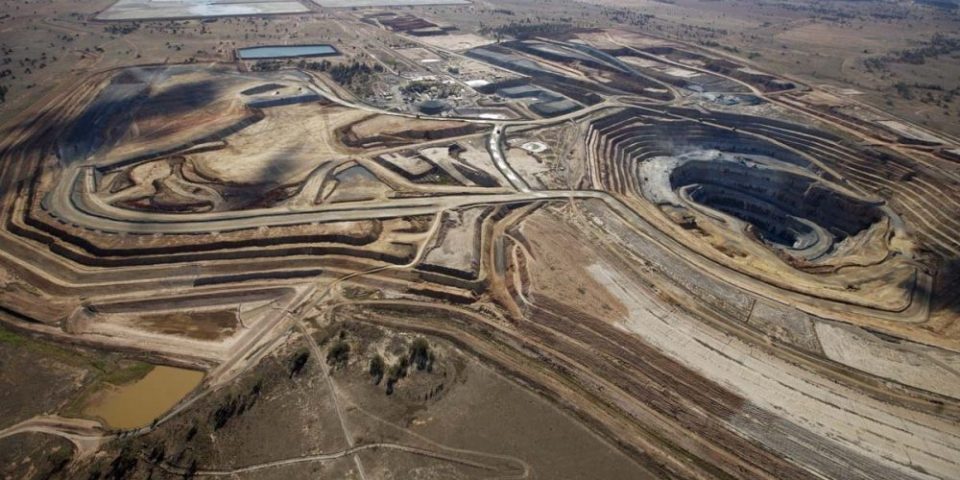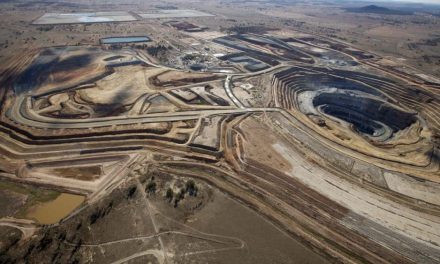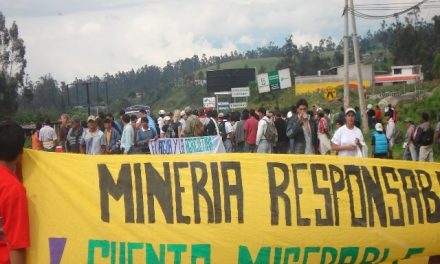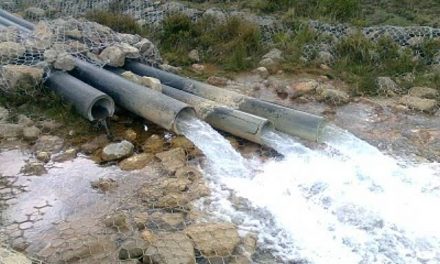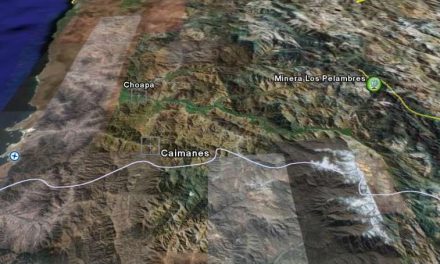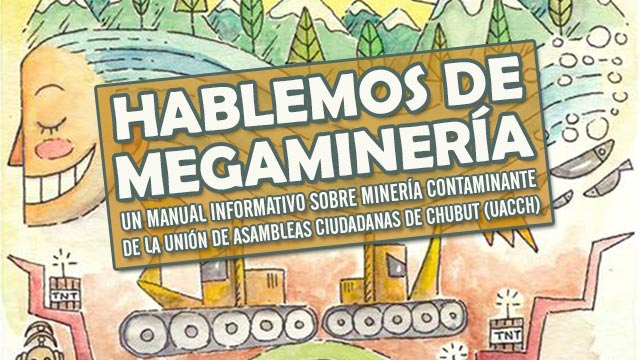High in the Andean mountains of Peru is a gold mine, Yanacocha, run by Newmont Mining Corporation of Denver, Colorado, the largest gold mining company in the world. Once part of the Incan Empire, this land was conquered by the Spanish, who came in search of gold and silver. Descendants of the Incas remain suspicious to this day of outsiders seeking fortune here. FRONTLINE/World and New York Times reporter Lowell Bergman arrives to investigate a growing conflict between the local people and the Yanacocha Mine, which has already produced $7 billion worth of gold.
“In the language of the local Indians, Yanacocha means `black lake,' but the lake is long gone,” says Bergman, “a casualty of this massive mining operation.”
Today, the Yanacocha Mine spreads across more than 60 square miles at altitudes as high as 14,000 feet. Mine manager Brant Hinze tells Bergman that nearly $2 billion has been invested in the mine. Dressed in protective gear and wearing a respirator, Bergman is allowed to enter the heavily guarded “gold room,” where ore is melted at a temperature of 2000 degrees Fahrenheit and the liquid gold is poured into bars worth more than $180,000 each. The golden scene of flowing molten metal resembles some ancient rite.
“There's a tradition among gold miners,” says Bergman. “They say if you can lift a brick with one hand, it's yours to keep.” Bergman makes a valiant effort, but it proves impossible.
The Yanacocha Mine recently celebrated the pouring of its 19 millionth ounce of gold. It is said to be the world's most productive gold mine.
“But behind the company's success is a dark and troubled history with allegations of corruption and bribery,” says Bergman. It is a story that begins in 1994 during the presidency of Alberto Fujimori — and provides a case study of “how a multinational company does business in a developing country rife with corruption.”
The original owners of the Yanacocha Mine were Newmont; Buenaventura, a Peruvian company; and Bureau de Recherches Géologiques et Minières (BRGM), a French government-owned company. But the partnership collapsed when the French tried to sell part of their shares to an Australian company that was a competitor of Newmont. Newmont and Buenaventura went to court to stop the French, and an epic battle ensued, pitting Newmont against the French company. Billions of dollars were at stake.
“The French government was behaving inappropriately in the litigation,” says Larry Kurlander, a former Newmont senior executive. “In fact, I have seen with my own eyes a letter from [French president] Jacques Chirac to President Fujimori asking for his intervention in the case.” Newmont sent Kurlander, a troubleshooter and former prosecutor, to Peru to “level the playing field” and help the company win their court case against the French. This is the first time Kurlander, an insider, has spoken publicly about what happened.
The legal fight went all the way to Peru's notoriously corrupt Supreme Court. Kurlander claims that the French were trying to bribe Peruvian politicians to influence the judges. But Antoine Blanca, France's ambassador to Peru at the time, denies that the French were paying bribes. On the contrary, Blanca tells Bergman, it was Newmont who was bribing people. Kurlander insists that is not true, but he does admit that he met privately with Vladimiro Montesinos, a very unsavory character who was President Fujimori's right-hand man, in an effort to enlist his help in thwarting the French. Kurlander argues that he had no choice, that he had to meet with Montesinos because “if the French were to be stopped, he was the only one in Peru who would dare to do it.”
Montesinos is a notorious figure, “a crooked lawyer who made a short career of defending drug traffickers” before becoming “for all practical purposes” the man in charge of the Peruvian army and intelligence services, according to Mirko Lauer, a leading Peruvian journalist. It turns out that Montesinos was in the habit of secretly recording most of the meetings in his office. Many of these videotapes were later leaked to the press, causing the downfall of President Fujimori in 2000 and the arrest of Montesinos. “The videotapes show Montesinos cutting deals, bribing officials and handing out bricks of cash,” says Bergman, as we see excerpts from these tapes, never before shown on television in the United States.
In one audio tape, Newmont's Kurlander meets with Montesinos, and the men part with a pledge of loyalty: “Now you have a friend for life.”
Kurlander also lobbies the U.S. State Department to come to the aid of Newmont. Peter Romero, who was Assistant Secretary of State in charge of Latin America, tells Bergman that he actually called Montesinos on behalf of Newmont, though he was only trying to level the playing field. After the case was finally decided in Newmont's favor, Romero went to work for Newmont as a consultant.
Blanca says the French refused to meet with a criminal like Montesinos; moreover, they knew something else: “He was a CIA man.”
Bergman's former CIA sources confirm that the CIA was paying Montesinos's secret police organization at least a million dollars a year and had done so for more than a decade. And in two of the secret videotapes, Montesinos is seen meeting with the CIA station chief in Lima, Peru's capital. On one tape, Montesinos vows to block what he says is evidence of French pressure on Peru's courts in the gold mine dispute.
In the most revealing of the tapes, Montesinos meets with the judge who will cast the deciding vote in the case, explaining that Peru needs Washington's support in a border dispute with Ecuador. A week later, the judge casts his vote in favor of Newmont, and Newmont wins controlling interest in the Yanacocha Mine.
Today, Montesinos is being held in a maximum-security prison in Peru, standing trial on dozens of counts of corruption. Kurlander tells Bergman he regrets meeting with Montesinos: “… the fact that you are in a country and you are forced to deal with a guy like this, it's a terrible thing.”
In Peru, Ronald Gamarra — the special prosecutor assigned to investigate judicial corruption under Montesinos — tells Bergman, “My theory is that both sides [the French and the Americans] were trying to get a favorable decision by any means necessary, but only one side got to Montesinos and that is the side that won.” But Gamarra says he was removed from the case before he could complete his investigation. Nevertheless, he declares, “I am sure bribes were paid.”
Neither Newmont nor the French nor the Peruvian judge who met with Montesinos was ever convicted of participating in illegal activities in connection with the gold mine case. Under the Foreign Corrupt Practices Act, the U.S. government did investigate allegations that Newmont paid bribes. “But that investigation ended late last year after the Peruvian government failed to fully cooperate and the statute of limitations ran out,” says Bergman.
Today, Newmont is firmly in control of the Yanacocha Mine, but the company has encountered resistance from the local population. Some of the distrust of the mine and its operators may go back to the story of Atahualpa, the Incan emperor who was captured and held for ransom by the Spanish. To win his freedom, Atahualpa promised his captors to fill a room with gold, but the Spanish betrayed him — they took the gold and killed him anyway.
Foreigners have been taking Peru's mineral wealth ever since, says Lauer: “And this is the basic historical lesson of these times, no? Unhappy people surrounded, watching very happy transnational corporations moving earth and digging gold.”
In part, the sheer scale of the mining operation — and its reliance on cyanide to recover the microscopic bits of gold in the crushed rock — worries many campesinos in the region. “They are destroying our water, our hills, our flora and fauna,” Miguel Garcia, a dairy farmer, tells Bergman, though Newmont says they safely contain the cyanide solution in lined holding ponds.
Trust between the campesinos and the mine really broke down in June 2000, when a truck contracted to carry mercury from the mine accidentally spilled 330 pounds of its toxic cargo over a 25-mile stretch of road around the village of Choropampa. Not knowing what it was, but attracted by the mercury's glimmer, villagers picked it up and took it home. They later fell sick, and many ended up in hospitals with symptoms of mercury poisoning. More than a thousand people are suing Newmont in a U.S. federal court for damages.
“Nobody was dead,” says Roque Benavides, the CEO of Newmont's partner, Buenaventura. He also says that the company provided health insurance. “So it was not all that bad.”
But the mercury spill provoked violent clashes between angry villagers and the police. It became a public relations nightmare for Newmont, and the company decided to dispatch Kurlander back to Yanacocha to see how the mine was operating. Kurlander's environmental audit found 20 high-priority problems at the mine. The findings were so serious that Kurlander warned in a memo to Newmont CEO Wayne Murdy that senior executives could be subject to “criminal prosecution and imprisonment.”
For Kurlander, the environmental report was a turning point: “When we are out there preaching that we are guardians of the environment and you suddenly discover that we are not, it's like someone hits you in the stomach real hard.”
Less than a year later, Kurlander retired from Newmont. Bergman requested an interview with Murdy to discuss the Yanacocha case, but Murdy declined. Since Kurlander's environmental audit, however, the company says they have spent more than $100 million on environmental improvements at the mine in Peru. They also provide more than 2,000 full-time staff jobs at the mine and pay substantial taxes.
The problem now for Newmont, according to Kurlander, is that the company has not regained the trust of many local people in Peru. Kurlander argues that Newmont needs something more than the government license it has to operate the Yanacocha Mine — it needs a “social license” from the community. Benavides is skeptical of the “social license” concept, but the mine's manager tells Bergman he recognizes the need to work with and help the Indians in this impoverished region. Hinze says he hopes the mine “will be a neighbor here for a very long time'” and will continue to expand.
However, protesters have blocked the mine's plans to expand operations into a mountain called Cerro Quilish, which Newmont believes contains more than a billion dollars' worth of gold. For campesinos, Quilish is a sacred mountain and a source of precious water. “For Yanacocha, Quilish is a mountain of gold,” says Catholic priest and local activist Father Marco Arana, “and for the people, it is a mountain of water. And Yanacocha didn't listen to the people.”
Last fall, thousands of Peruvians filled the town square in Cajamarca, the city closest to the mine, protesting the expansion. Later they blockaded mining roads and forced the company to cancel its expansion plans.
“Communities are becoming more and more involved in their own destinies,” says a chastened Kurlander. “When I say a social license, I mean it. Without the community support, you'll be out of business eventually. They will force you out of their community, and it doesn't matter how much government support you have.”

